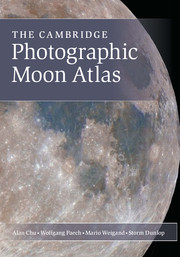Book contents
- Frontmatter
- Preface
- Advice on using this book
- Contents
- The Moon – an introduction
- Atlas of lunar formations
- 1 Mare Smythii
- 2a Mare Crisium
- 2b Mare Crisium
- 3 Cleomedes
- 4 Endymion
- 5 Atlas/Hercules
- 6 Montes Taurus
- 7 Palus Somni
- 8a Mare Fecunditatis
- 8b Mare Fecunditatis
- 9 Langrenus/Petavius
- 10 Mare Australe
- 11 Vlacq
- 12 Vallis Rheita
- 13a Mare Nectaris
- 13b Mare Nectaris
- 14 Rupes Altai
- 15 Abulfeda
- 16 Theophilus
- 17 Sinus Asperitatis
- 18 Statio Tranquillitatis
- 19a Mare Tranquillitatis
- 19b Mare Tranquillitatis
- 20a Mare Serenitatis
- 20b Mare Serenitatis
- 21 Posidonius
- 22 Lacus Mortis
- 23 Aristoteles/Eudoxus
- 24 Montes Caucasus
- 25 Autolycus/Aristillus
- 26 Cassini
- 27 Montes Alpes
- 28 Plato
- 29 Montes Teneriffe
- 30 Archimedes
- 31a Montes Apenninus
- 31b Montes Apenninus
- 32 Mare Vaporum
- 33 Rima Ariadaeus
- 34 Rima Hyginus
- 35 Sinus Medii
- 36 Hipparchus
- 37a Ptolemaeus
- 37b Ptolemaeus
- 38 Rupes Recta
- 39 Regiomontanus
- 40 Maurolycus
- 41 South Pole
- 42 Clavius
- 43 Tycho
- 44 Schiller
- 45 Palus Epidemiarum
- 46 Pitatus
- 47 Mare Nubium
- 48 Fra Mauro
- 49 Mare Cognitum
- 50 Mare Insularum
- 51a Copernicus
- 51b Copernicus
- 52 Eratosthenes
- 53a Mare Imbrium
- 53b Mare Imbrium
- 54 Sinus Iridum
- 55 Gruithuisen
- 56 Mare Frigoris
- 57 North Pole
- 58 Aristarchus
- 59 Kepler
- 60 Seleucus
- 61 Reiner
- 62 Letronne/Hansteen
- 63 Gassendi
- 64 Mare Humorum
- 65 Schickard
- 66 Sirsalis
- 67 Grimaldi
- 68 Mare Orientale
- 69 Lunar Farside
- Glossary
- Index of lunar features
- Image credits
- Further reading and references
15 - Abulfeda
Published online by Cambridge University Press: 05 October 2012
- Frontmatter
- Preface
- Advice on using this book
- Contents
- The Moon – an introduction
- Atlas of lunar formations
- 1 Mare Smythii
- 2a Mare Crisium
- 2b Mare Crisium
- 3 Cleomedes
- 4 Endymion
- 5 Atlas/Hercules
- 6 Montes Taurus
- 7 Palus Somni
- 8a Mare Fecunditatis
- 8b Mare Fecunditatis
- 9 Langrenus/Petavius
- 10 Mare Australe
- 11 Vlacq
- 12 Vallis Rheita
- 13a Mare Nectaris
- 13b Mare Nectaris
- 14 Rupes Altai
- 15 Abulfeda
- 16 Theophilus
- 17 Sinus Asperitatis
- 18 Statio Tranquillitatis
- 19a Mare Tranquillitatis
- 19b Mare Tranquillitatis
- 20a Mare Serenitatis
- 20b Mare Serenitatis
- 21 Posidonius
- 22 Lacus Mortis
- 23 Aristoteles/Eudoxus
- 24 Montes Caucasus
- 25 Autolycus/Aristillus
- 26 Cassini
- 27 Montes Alpes
- 28 Plato
- 29 Montes Teneriffe
- 30 Archimedes
- 31a Montes Apenninus
- 31b Montes Apenninus
- 32 Mare Vaporum
- 33 Rima Ariadaeus
- 34 Rima Hyginus
- 35 Sinus Medii
- 36 Hipparchus
- 37a Ptolemaeus
- 37b Ptolemaeus
- 38 Rupes Recta
- 39 Regiomontanus
- 40 Maurolycus
- 41 South Pole
- 42 Clavius
- 43 Tycho
- 44 Schiller
- 45 Palus Epidemiarum
- 46 Pitatus
- 47 Mare Nubium
- 48 Fra Mauro
- 49 Mare Cognitum
- 50 Mare Insularum
- 51a Copernicus
- 51b Copernicus
- 52 Eratosthenes
- 53a Mare Imbrium
- 53b Mare Imbrium
- 54 Sinus Iridum
- 55 Gruithuisen
- 56 Mare Frigoris
- 57 North Pole
- 58 Aristarchus
- 59 Kepler
- 60 Seleucus
- 61 Reiner
- 62 Letronne/Hansteen
- 63 Gassendi
- 64 Mare Humorum
- 65 Schickard
- 66 Sirsalis
- 67 Grimaldi
- 68 Mare Orientale
- 69 Lunar Farside
- Glossary
- Index of lunar features
- Image credits
- Further reading and references
Summary
Abulfeda 13.8°S, 13.9°E
Abulfeda is a very regularly formed crater with a diameter of 65 km and a depth of 3.1 km. The crater floor is relatively smooth and flat, and the southern, inner crater wall exhibits features like landslides. Fairly central there is a craterlet that is surrounded by a very bright halo of ejecta. Large telescopes show additional crater pits and hills on the crater's floor. Abulfeda is a typical crater, like many of the others that were formed during the Nectarian period (between 3.92 and 3.85 billion years ago).
Abenezra 21.0°S, 11.9°E
An almost rectangular crater with a diameter of 43 km and a wall height of about 3.7 km, measured from the crater's floor. The crater Abenezra C (44 km) to the west and partly overlapped by Abenezra, forms part of a trio of craters with Azophi.
Azophi 22.1°S, 12.7°E
A crater 48 km in diameter and 3.7 km deep.
Descartes 11.5°S, 15.7°E
The region around the crater Descartes is very interesting and was therefore chosen as the landing site for Apollo 16. Geologists expected soil samples to be of volcanic origin. Contrary to the lunar geologists' assumptions no rocks of any form of volcanic origin were found in the region.
Descartes is a heavily eroded crater, 48 km in diameter, and exhibits a bright area, extending out from the northern crater wall. The material consists of breccia and once molten highland material. The origin of the bright ejecta is uncertain. The crater wall of Descartes A (16 km) also appears extremely bright in sunlight. In 1999, the lunar probe Lunar Prospector flew over this area at a low altitude and registered strong magnetic anomalies beneath the lunar surface (a magcon). The Descartes region obviously still holds many unsolved riddles.
- Type
- Chapter
- Information
- The Cambridge Photographic Moon Atlas , pp. 67 - 68Publisher: Cambridge University PressPrint publication year: 2012

